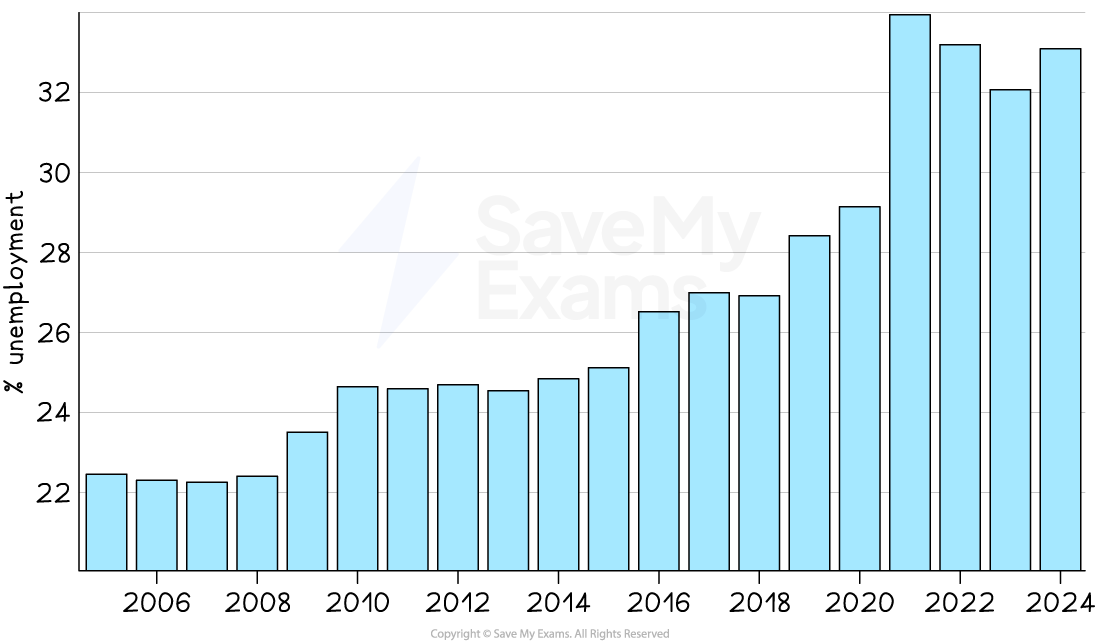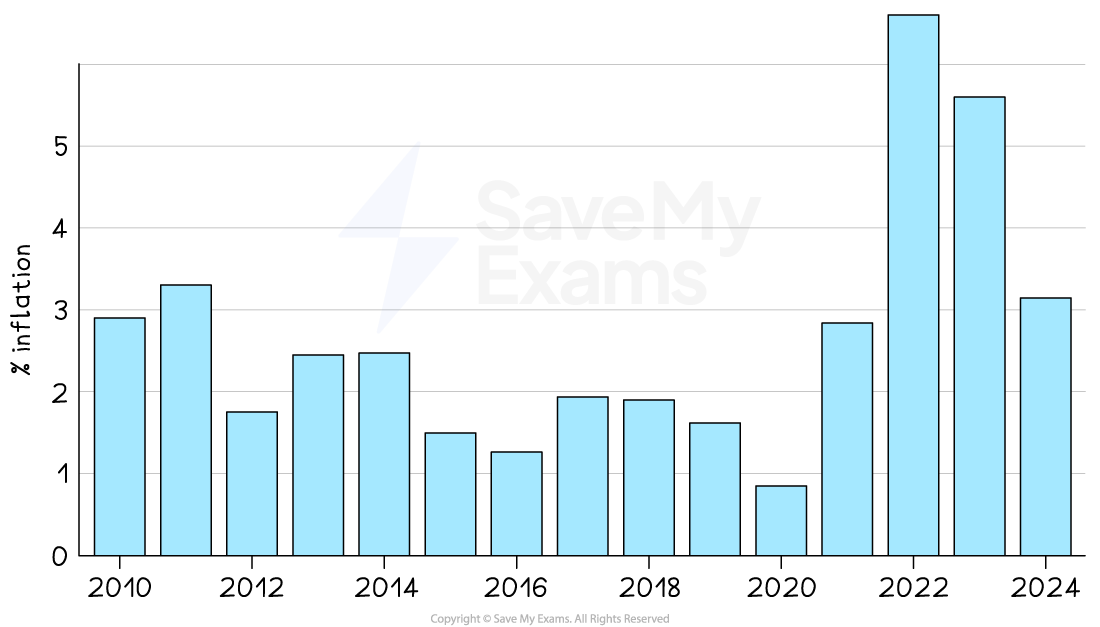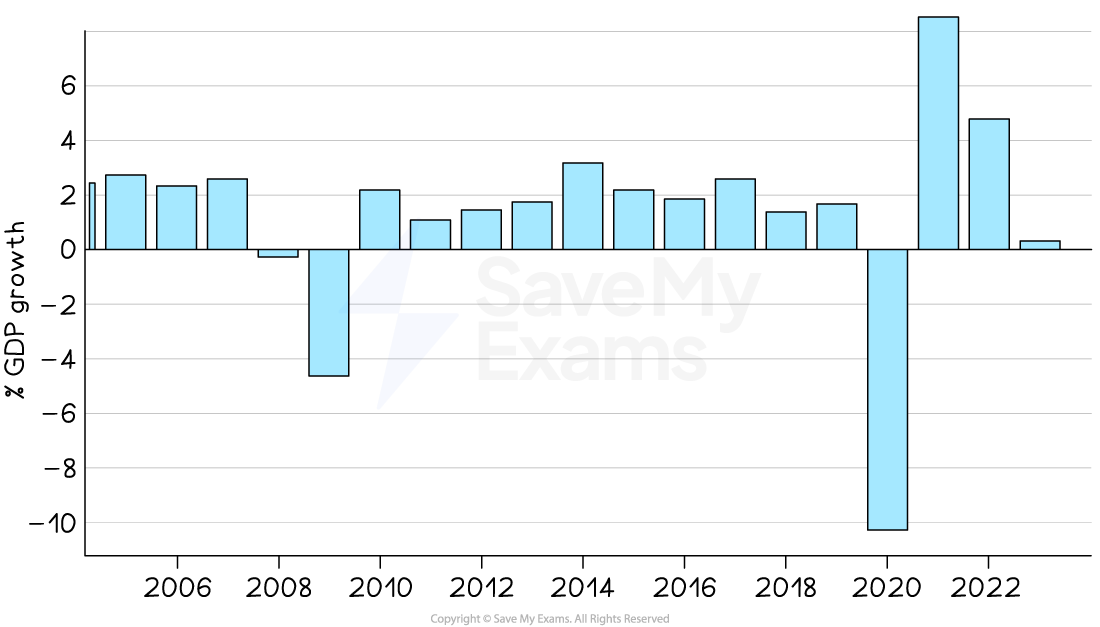Economic: Government Macroeconomic Objectives (Cambridge (CIE) A Level Business): Revision Note
Exam code: 9609
An introduction to macroeconomic objectives
Macroeconomic objectives are the main goals that a government tries to achieve in the wider economy to keep the economy stable and growing
Successfully meeting the objectives helps improve living standards and create a strong business environment
Macroeconomic objectives usually include
Economic growth – increasing the total output of goods and services in the country (measured by GDP)
Low unemployment – making sure most people who want to work can find a job
Low and stable inflation – keeping prices from rising too quickly
Low unemployment
The target unemployment rate for many economies is between 2-5%
In December 2022 the unemployment rate in the USA was 3.7% and in Singapore it was 2.6%
Low unemployment rates like this are close to the full employment level of labour
There will always be a level of frictional, seasonal and structural unemployment
This makes it impossible to achieve 100% employment
Different economies have different unemployment rates that are considered to be close to the full employment level of labour
E.g. Japan's level is about 2.5% while India's is about 5.7%
There is an increased emphasis on the unemployment rate within different sections of the population
E.g. Youth unemployment, ethnic/racial unemployment by group
In 2021, black unemployment in the UK was 11% and white unemployment was 4.%

Unemployment tends to be inversely proportional to real GDP growth
When real GDP increases, unemployment falls
When real GDP decreases, unemployment rises
Impact on business activity
Higher employment levels mean more people have income to spend, which increases consumer demand for goods and services
Lower unemployment reduces the availability of labour, making it harder for firms to recruit – this may push up wage costs
High employment increases business confidence, encouraging firms to invest and expand
In areas or sectors with high unemployment, demand may fall, leading to lower sales and possible business closures
Businesses may be able to recruit workers more cheaply during periods of high unemployment, improving labour cost competitiveness
Low and stable inflation
Many economies have a target inflation rate of 2% using the Consumer Price Index (CPI)
A low and stable rate of inflation is desirable, as it is a symptom of economic growth
The different causes of inflation (cost push or demand pull) require different policy responses from the Government
Demand-side policies ease demand pull inflation
Supply-side policies ease cost push inflation

In the UK, a significant deviation from the target of 2% would not be considered stable
An inflation ratea of 3% is considered to be unstable, eroding household purchasing power
By October 2022 the inflation rate in Australia had risen to 6.59%
A low and stable rate of inflation is important as it
Allows firms to confidently plan for future investment
Offers price stability to consumers
Impact on business activity
Low and stable inflation helps businesses plan ahead with greater confidence in costs and pricing strategies
High inflation increases input costs (e.g., wages, raw materials), reducing profit margins unless firms can raise prices
Unstable inflation creates uncertainty, making it harder to budget, forecast, or make investment decisions
Inflation may erode consumer purchasing power, reducing demand for non-essential goods and services
In countries with high inflation, businesses may face pressure to increase wages, which can increase overall operational costs
Economic growth
Economic growth is a central macroeconomic aim of most governments
Many developed nations have an annual target rate of 2-3%
This is considered to be sustainable growth
Growth at this rate is less likely to cause excessive demand pull inflation
Politicians use the economic growth rate as a measure of the effectiveness of their policies and leadership
Economic growth has positive impacts on confidence, consumption, investment, employment, incomes, living standards and government budgets

Economic growth trends in the UK since 1998
1998 - 2007
Steady growth fluctuating between 2-4%
2008 - 2015
Global financial crisis followed by a rapid bounce back due to government intervention - and then steady growth
2016 - 2019
Gradual disinflation possibly due to future expectations regarding the impact of the Brexit vote
2020 - 2021
Covid resulted in significant economic slumps on a global basis during 2020
These created a deep recession (short-lived due to government intervention)
Many economies rebounded in 2021
2022 - 2025
Supply chain issues due to Covid and Brexit continued
Increases in the interest rate reduced the level of economic activity
Impact on business activity
Growth boosts consumer incomes and spending power, increasing demand for most goods and services
Rising demand encourages businesses to expand capacity, hire more workers, and invest in new products or technology
Economic booms can lead to higher profits for firms, improving shareholder returns and business sustainability
High growth can also cause overheating, leading to labour shortages or inflationary pressures, which may affect input costs
A lack of growth (or recession) can lead to lower consumer confidence, reduced investment, and declining business revenues

Unlock more, it's free!
Did this page help you?